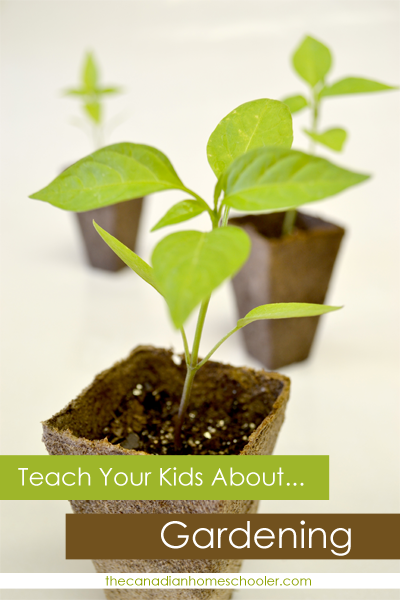Spring means plants and flowers and vegetable gardens. Here’s a round up of some great tools and resources to teach your kids about gardening. 
Lessons
- Lessons and Activities on KidsGardening.org
- How to Grow Beans in a Plastic Bag by Green Education Foundation – lesson and worksheet
- Flowers Interactive Science Notebook on The Curriculum Corner
- Growing a Kinder-Garden Unit by Mrs. Ricca’s Kindergarten
Badges
- Boy Scouts Gardening Merit Badge Requirements
- Scouts Canada Gardening Badge Requirements
- DIY.org Gardener Badge
Gardening for Kids Websites
- My First Garden by the University of Illinios – includes a planner, journal, and kid friendly articles on all sorts of gardening topics
- Kids’ Valley Garden
Lapbooks/Notebooking/Worksheets
- Gardening & Plants Lapbooks on Homeschool Share (listed by level)
- Gardening Lapbook by Amanda Bennett –intended to be used with her Garden Unit Study – costs $
- My Garden Lapbook on Lapbook Lessons
- Kids’ Healthy Kids’ Garden Activities by Nourish Interactive – printables including a journal, colouring sheets, puzzles, and worksheets
- Preschool Flower Unit Pack & Tot Pack from 2TeachingMommies
- Plant Observation Book by Swimming Into Second
- Plant Growing Observation Sheet by Kristy Myatt
- My Plant Journal by Amanda Richardson
- Garden Graphing by Stephanie Kinley
- Plants and Gardening Literacy Sampler Pack by Sallie Borrink
Plants
-
- Plant Life Cycle Notebook from 123 Homeschool 4 Me
- Plant a Garden: Plant Parts and Needs by Teaching in Progress
- Grow Beans in a CD Case by 2BusyBrunettes (linking to pinterest picture since pics are missing on main blog post)
- Parts of a Plant Worksheets on Worksheet Place
- Parts of a Plant Interactive Notebook by Promoting Success
- Plant Life Cycle Order Worksheet by Caroline Soesbee
Garden Planning
- Garden Planner for Kids by Harrington Harmonies
- Kids Garden Planner and Unit from Making Montessori Ours
- Kitchen Garden Planner by Gardeners’ Supply Company – a drag & drop square ft garden planner
Starting Seeds
- Garden Hardiness Zones for Canada, the US, and Europe
- Starting seeds using egg cartons or toilet paper tubes on Kitchen Chronicles
- Newspaper Pots on HGTV
Compost
-
- Composting for Kids slideshow
- Composting Ideas for Children on Gardening Know-How
- Kids’ Garden Crafts on KiddieGardens
- 20 Garden Projects for Kids on Craftionary
- DIY Sensory Garden by Modern Parents, Messy Kids
- Play Garden Centre on iVillage
- Garden Stepping Stones on Gardening Know How – also lots of great kid gardening ideas
Books
Latest posts by Lisa Marie Fletcher (see all)
- How to Keep a Toddler Busy While Homeschooling - March 21, 2024
- 25+ Things Your Kids Learn From Video Games - March 20, 2024
- 10 Words For New Homeschoolers - March 20, 2024






What a thorough collection of resources. I’m going to pin this for use later. I am sure it will come in handy.
Hey, thanks for the post.Really thank you! Really Cool.
Wow!! What an incredible list of resources!! How I love garden activities 🙂 Thank you so much for linking to us:) I am pinning this to our Kids in the Garden Board.http://www.pinterest.com/cherinexa/kids-in-the-garden/